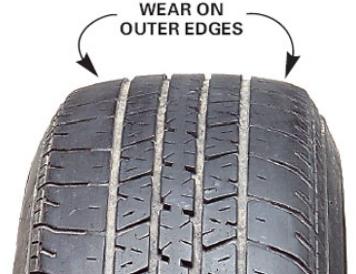How do I know if my tyre tread is legal? Are tyres legal to wear? Why do tyres wear on the outside edge? What does it mean when your tyres are on the outside edge?
Tyre wear on the outside edge could indicate something is wrong, such as: Under-inflation or leaks. If your tyres are worn on the inside and outside edge, they could be under-inflated or leaking.
This could cause the edges of your tyres to have more contact with the road than usual. Taking corners too fast.
The easiest way to check your tyre tread is still legal is to look out for tread wear indicators. If the tyre tread has become level with the top of the wear indicator, it means your tyres have reached the legal limit of 1. The inside edge, outside edge, or shoulder will show considerably more wear than the rest of the tyre.
Source of issue Camber wear can be caused by: suspension misalignment, a bent strut, a dislocated strut tower, a weak or broken spring, a bent spindle, or collapsed or damaged control arm bushings. A regular check of your tyres can help you to avoid penalty points and £5in fines for having tyres worn beyond the legal minimum limit on your vehicle.
It is also a legal requirement to ensure that tyres of different construction types are not fitted to opposite sides of the same axle. Risks of Front Tires Wearing on the Outside Edge.
The more worn the outer edge of the tire, the bigger the risk of a tire blowout. You should consider such tires bald and replace them as soon as possible.
A brand new tyre will have around 8mm of tread and over time, with regular driving it will begin to wear down. Uneven wear might be a sign of incorrect tyre pressure or a wheel alignment issue.
In the UK, the legal limit of tyre tread is 1. How to avoid a tread wear MOT fail If your treads look shallow, and the tyre surface somewhat shiny or bal they’re worn, and so it’s time to think about a new set of tyres. Make sure you’re UK road legal by placing a 20p piece inside the tyre treads (at different places across the tyre’s width).
Tyre and safety experts believe the 1. Tests by UK technical organisation MIRA found that, once tyres are below 3mm, stopping distances increase dramatically. When a tyre is brand new the tyre tread is around 8mm.
The legal minimum tyre tread is 1. Tyre tread below this measurement is not thought to provide enough traction to the road to ensure safety when driving. However, many experts believe tread of 1. For safety reasons it is recommended that you replace your tyres before the legal limit is reached. Spare tyres are not included in the inspection, but you should tell the presenter if you notice a defect. The aspect ratio of a tyre is included in the size marking.
If the treads are worn, the tyres are actively dangerous, which is why there’s a legal minimum tread depth of 1. The result is wear on the block run-out edge and is more likely to appear on non-driven wheels.
A minor amount of heel and toe wear is reasonable and has no discernible effect on driving comfort. But if the wear is more extensive, more specific issues could be to blame, including improper inflation, excessive toe-in and low- wear applications. Checking tyre tread with tyre tread wear indicators. If the tyre is flush with these, it is below the legal limit and needs replacing.
These are purpose made tools that quickly measure the depth of an individual tyre groove. One-sided shoulder tire wear : This type of irregular tread wear means the inside or outside shoulder rib of the tread is significantly more worn than the other ribs.
Also known as camber wear, excessive positive or negative camber often causes this type of wear. The law requires that tyres should not have any cuts or bulges and the tread depth should be a minimum of 1.

No comments:
Post a Comment
Note: only a member of this blog may post a comment.